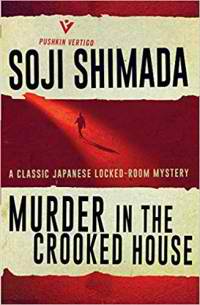Murder in the Crooked House by Soji Shimada
 Wednesday, June 26, 2019 at 7:40AM
Wednesday, June 26, 2019 at 7:40AM 
Published in Japan in 1982; published in translation by Pushkin Vertigo on June 25, 2019
Murder in the Crooked House is a locked room murder mystery that Soji Shimada divided into acts and scenes. A locked room murder in the first act is followed by another in the second. The novel challenges the reader not just to identify the killer but to figure out how the murders were committed. The latter is the more difficult challenge.
Kozaburo Hamamoto constructed the Crooked House, an isolated Western-style house next to a leaning glass tower, at the tip of Japan’s northernmost island. Hamamoto is a reclusive millionaire. He invites a few elite businessmen and their glamorous wives to a Christmas party at his Crooked House, as well as a couple of students. The chef, chauffeur, and maid are also present.
The students both have an interest in marrying Hamamoto’s daughter Eiko. Hamamoto puts a puzzle to them, offering his daughter’s hand (if she so wishes) to the winner. The challenge is to determine the significance of the flowerbed at the base of the tower. The significance will be revealed at the novel’s end.
Later that night, a female guest sees the face of a monster in her window — seemingly impossible since her room is on the third floor. The next morning, the chauffeur is found dead in his room with a knife protruding from his chest. The only door is locked from the inside. An art object, sort of like a large puppet or mannequin, is found in the snow outside his room. This turns out to be part of Hamamoto’s impressive collection of wind-up toys and other figures. He calls it a golem.
DI Okuma, DCI Ushikoshi, and DS Ozaki lead the police investigation. They take note of the house’s unusual design, which makes it difficult to move from room to room. A guest might need to climb down one staircase, walk the length of the house, and climb up a different staircase to access an adjacent room. The house is built on a slant and there are gaps between walls and the floor. The intricacies are difficult to follow, but Shimada provides helpful diagrams and maps of the house and murder scene.
Murder in the Crooked House is a classic locked room mystery. Several people were staying in the crooked house, all had gone to bed, most of them had their own room and no alibi, and none had an obvious motive to murder the chauffeur. The second murder is of a lecherous old man. This time, the only guests who had a motive were in the company of a police officer at the time the killing occurred.
The detectives are frustrated and, by the end of Act Two, they are wishing they had the assistance of a Japanese Sherlock Holmes. Enter Kiyoshi Mitarai, the star of Act Three. Mitarai’s role in the story is narrated by his own version of Watson, Kazumi Ishioka. Prior to the final act, the reader is assured that all the clues are in place and is challenged to solve the mystery.
And it’s true, the clues are there, but only a reader with some esoteric knowledge of Japan (and perhaps the ability to speak Japanese) will be able to unlock all of them. Most of the clues, however, would allow a reader to piece together how the murders were committed. To do so, the reader would need to be more astute than I am. Guessing the killer’s identity is somewhat easier.
The plot provides readers with an entertaining murder mystery, but the story is fascinating in its glimpse of certain aspects of traditional Japanese culture. A wife complains that her husband, a salaryman, is sycophantic in his relationship with a business owner, but bullying and bossy when he is at home. An older businessman is sleeping with his much younger secretary but hiding his conduct for the sake of appearances. The detectives are more worried about saving face than catching the killer. The murderer’s motivation for one of the killings is related to Japanese history. When the murderer is revealed, the unfailingly polite detectives fall over themselves to compliment the killer on an ingenious plan. And, of course, the polite murderer praises the investigator who solves the crime. What a nice place Japan must be to live (if you can avoid being murdered).
Mitarai isn’t quite Sherlock, but he brings a theatrical flair to his detecting style. An epilog gives the story a final twist. Murder in the Crooked House is a good choice for fans of Japanese crime fiction and a really good choice for fans of locked room murder mysteries.
RECOMMENDED
 TChris |
TChris |  Post a Comment |
Post a Comment |  Japan,
Japan,  Soji Shimada in
Soji Shimada in  Thriller
Thriller